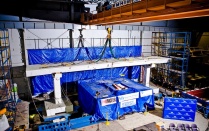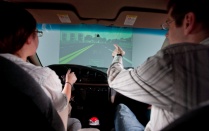New resilient design concept keeps bridges open after earthquakes

Michel Bruneau, SUNY Distinguished Professor (left) and Homero F. Carrión Cabrera, Fulbright-SENESCYT Scholarship recipient and PhD student (right), are developing a new design concept to keep bridges operational after earthquakes.
By Peter Murphy
Published April 26, 2022
Research is underway at the University at Buffalo on a new low-cost resilient bridge design concept to eliminate bridge closures and repairs following earthquakes.
The concept uses inexpensive braces called Buckling Restrained Braces (BRBs) and sliding bearings that work together to protect the bridge columns and superstructure from damage, so that the bridge can withstand the three-dimensional ground motions caused by earthquakes.
“The braces work as fuses; in the event of an earthquake, they get damaged instead of other parts of the bridge. As a result, after an earthquake, the bridge will be totally operational even in the case that the braces need to be replaced,” says Homero Carrión Cabrera, a PhD student and recipient of the Fulbright-SENESCYT Scholarship, a combined scholarship from the U.S. Ecuador, his home country.
“This design strategy fully meets the broadly accepted resilience objectives of minimizing losses and time for recovery,” says Michel Bruneau, lead investigator of the project and SUNY Distinguished Professor in the Department of Civil, Structural and Environmental Engineering.
To find the best combination of BRBs and end-connection details, Bruneau and Carrión Cabrera constructed a 2.5 scale model of a 100-foot bridge span. The model, which is a 40-foot long, 12-foot-wide, slab-on-girder bridge, was constructed almost entirely using materials donated by industry partners.
The BRBs were supplied by CoreBrace, and RJ Watson, Inc. provided the sliding bearings used at the bridge supports. High Steel Structures, High Concrete Group provided fabrication of the bridge girder/concrete deck specimen, and the American Institute of Steel Construction (AISC) donated the steel for the bridge.
Testing took place throughout February and March 2022 using the dual shake tables located in the Structural Engineering and Earthquake Simulation Laboratory (SEESL) at the University at Buffalo.
“Four different BRB configurations and end-connection details designed specifically for this application were tested in the bridge span, where they were subjected to a series of ground motion excitations at, and exceeding, the design level,” says Bruneau.
“This step of validation is essential for endorsement by the practicing engineering community,” he added.

Carrión Cabrera preparing the bridge specimen for testing.
Bruneau and Carrión Cabrera, who are now processing the results from their testing, believe this concept could benefit new and existing bridges throughout the U.S.
“The simplicity of the proposed concept makes it an attractive solution for seismic design in all seismic regions – over 40 states across the U.S. Ductile diaphragms can be designed to accommodate any level of seismic forces, given that BRBs having capacities ranging from 20 to 1400 kips have already been designed and tested,” Bruneau says. “Beyond becoming a concept for new bridges, the solution can also be used to retrofit existing bridges.”
The results from the test program will be design guidelines and examples that can be readily used by the practicing engineering community. The guidelines are expected to be implemented by the American Association of State Highway and Transportation Officials (AASHTO) and state departments of transportation.
The project, “Achieving Resilient Multi-Span Bridges by using Buckling-Restrained Braces,” received $100,000 in funding from the National Cooperative Highway Research Program (NCHRP) as part of its IDEA (Innovative Deserving Exploratory Analysis) program. The IDEA program funds projects that are early-stage, high-risk, high-payoff, investigator-led research related to highways, transit and railroad safety and performance.
An additional $50,000 in financial support was provided by the California Department of Transportation, together with all the donations by industry partners.
At the conclusion of testing, the bridge specimen, which successfully survived dozens of earthquakes in the lab, found a second life: it was donated to the city of Kent, N.Y., to replace an older bridge that was washed out during a severe storm in 2018.
Check out some of the testing in SEESL in the video below:









